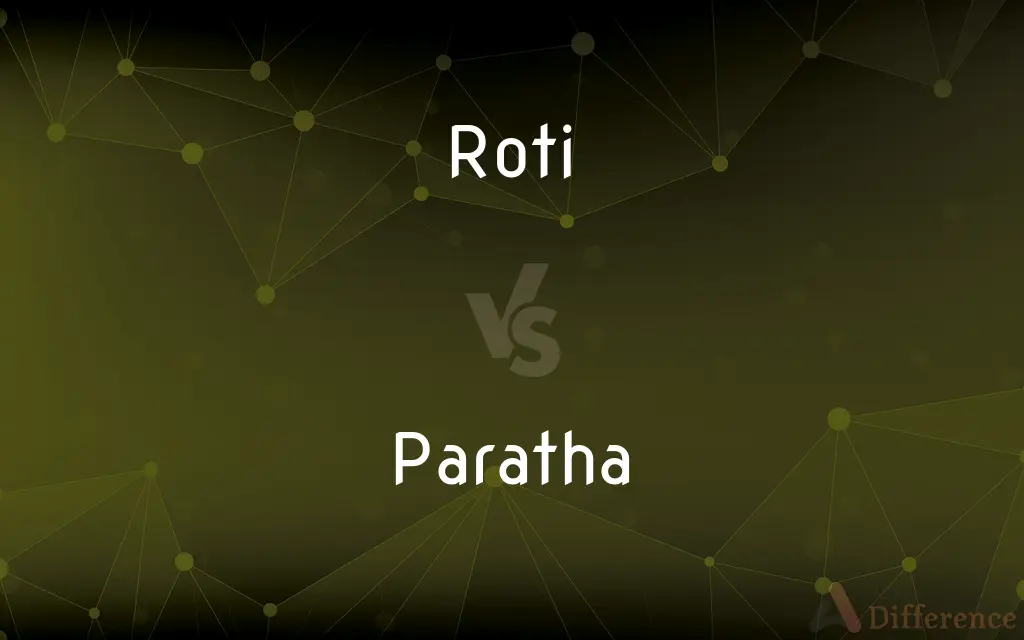Roti vs. Paratha — What's the Difference?
Edited by Tayyaba Rehman — By Urooj Arif — Updated on March 15, 2024
Roti is a simple, unleavened flatbread made with whole wheat flour, while paratha is a richer version, often layered and cooked with ghee or oil, sometimes stuffed with various fillings.

Difference Between Roti and Paratha
Table of Contents
ADVERTISEMENT
Key Differences
Roti, also known as chapati, is a staple in many South Asian cuisines, made from a simple dough of whole wheat flour and water, and then cooked on a hot griddle. It is known for its soft, pliable texture and is a daily bread for many households. Paratha, on the other hand, is a variation of roti that incorporates fat, like ghee or oil, into the dough, and is often layered or stuffed with ingredients such as vegetables, spices, or meats, making it more flavorful and rich.
The preparation of roti is straightforward, involving rolling out the dough into thin circles and cooking them on a tava (griddle) until they puff up, indicating they are fully cooked. Parathas require a bit more technique, with the dough being folded and rolled several times to create layers, and then cooked with a bit of fat to achieve a crispy, flaky texture.
Nutritionally, roti is often considered healthier due to its simplicity and lack of added fats, making it a suitable option for everyday consumption. Parathas, with their additional ingredients and cooking fat, are more indulgent and often enjoyed as a special or more filling meal.
Culturally, both roti and paratha hold significant places in South Asian cuisine, but parathas are particularly associated with festive or special occasions due to their rich taste and versatility in fillings. Both breads are commonly served with a variety of side dishes, such as curries, vegetables, or yoghurt, enhancing their flavors and making them integral parts of a meal.
In summary, while roti is a basic, everyday bread that complements a meal, paratha offers a richer, more decadent experience, with the potential for a wide range of flavors and textures depending on the preparation and fillings.
ADVERTISEMENT
Comparison Chart
Ingredients
Whole wheat flour, water
Whole wheat flour, water, ghee/oil, (optional fillings)
Preparation
Rolled out thin and cooked on a griddle
Layered or stuffed, then cooked with ghee or oil
Texture
Soft and pliable
Crispy and flaky
Nutritional Value
Lower in fat, considered healthier
Higher in calories due to fats and fillings
Serving Occasions
Daily meals
Special meals or occasions
Compare with Definitions
Roti
Whole wheat ingredient.
Roti is made with whole wheat flour for a nutritious meal.
Paratha
Layered flatbread.
The flaky layers of paratha make it a delicious treat.
Roti
Basic unleavened bread.
Roti is a staple accompaniment to Indian curries.
Paratha
Stuffed variety.
Aloo paratha, stuffed with spiced potatoes, is a popular breakfast.
Roti
Soft texture.
Freshly made roti is soft and warm, perfect for scooping up lentils.
Paratha
Cooked with fat.
Paratha gets its crispy texture from being fried in ghee.
Roti
Healthy option.
Roti is a healthier alternative to white bread due to its whole grains.
Paratha
Occasional indulgence.
Paratha is often reserved for special meals or weekends.
Roti
Daily bread.
Roti is often eaten daily in many South Asian households.
Paratha
Rich and flavorful.
The use of ghee makes paratha a richly flavored bread.
Roti
Roti (also known as chapati) is a round flatbread native to the Indian subcontinent made from stoneground whole wheat flour, traditionally known as gehu ka atta, and water that is combined into a dough. Roti is consumed in many countries worldwide.
Paratha
A paratha (pronounced [pəˈrɑːtʰə]) is a flatbread native to the Indian subcontinent, prevalent throughout the modern-day nations of India, Sri Lanka, Pakistan, Nepal, Bangladesh, Maldives and Myanmar, where wheat is the traditional staple. Paratha is an amalgamation of the words parat and atta, which literally means layers of cooked dough.
Roti
See chapati.
Paratha
An Indian bread with a texture somewhat resembling puff pastry; sometimes stuffed with vegetables etc.
Roti
A kind of unleavened flatbread commonly consumed in South Asia and the Caribbean.
Nepalis eat sweet fried rice-flour doughnuts called sel roti.
Common Curiosities
What is the main difference between roti and paratha?
The main difference lies in their ingredients and preparation; roti is simpler, while paratha is richer and often layered or stuffed.
Is paratha always stuffed?
Not always; plain parathas exist, but parathas are often known for their delicious fillings.
Is paratha less healthy than roti?
Generally, yes, due to the addition of fats and sometimes rich fillings, making paratha more calorie-dense.
Can roti and paratha be made from the same flour?
Yes, both are typically made from whole wheat flour, known as atta.
Can roti and paratha be made vegan?
Yes, both can be made vegan by using oil instead of ghee.
Are roti and paratha eaten at a specific time of day?
Roti can be eaten with any meal, while paratha, especially when stuffed or richly layered, is often enjoyed for breakfast or dinner.
Are rotis served with the same dishes as parathas?
Yes, both can be served with a variety of dishes like curries, vegetables, and yoghurt.
Do roti and paratha originate from the same region?
Both have roots in South Asian cuisine, though variations can be found in many countries within the region.
How are the layers in paratha created?
The layers in paratha are created by folding and rolling the dough multiple times before cooking.
Is it common to eat roti or paratha with hands?
Yes, in many cultures, it's customary to use roti or paratha to scoop up food, eating with your hands.
Is roti or paratha easier to make?
Roti is generally considered easier to make due to its simpler preparation.
Can leftover roti be turned into paratha?
While not traditional, leftover roti can be pan-fried with ghee or oil to mimic a paratha-like texture.
Can gluten-free flours be used for roti or paratha?
Yes, but the texture and taste may differ from traditional versions made with whole wheat flour.
How do you store leftover roti and paratha?
Leftovers can be stored in an airtight container in the refrigerator and reheated before serving.
Can roti and paratha be frozen for later use?
Yes, both can be frozen and reheated, though fresh is always best for optimal texture and flavor.
Share Your Discovery

Previous Comparison
Fiscal vs. Physical
Next Comparison
Aceclofenac vs. DiclofenacAuthor Spotlight
Written by
Urooj ArifUrooj is a skilled content writer at Ask Difference, known for her exceptional ability to simplify complex topics into engaging and informative content. With a passion for research and a flair for clear, concise writing, she consistently delivers articles that resonate with our diverse audience.
Edited by
Tayyaba RehmanTayyaba Rehman is a distinguished writer, currently serving as a primary contributor to askdifference.com. As a researcher in semantics and etymology, Tayyaba's passion for the complexity of languages and their distinctions has found a perfect home on the platform. Tayyaba delves into the intricacies of language, distinguishing between commonly confused words and phrases, thereby providing clarity for readers worldwide.













































